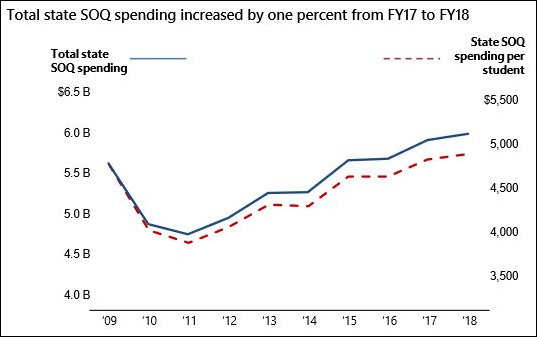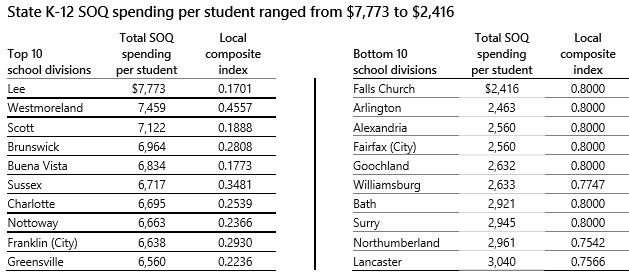Virginia spent about $6 billion in FY 2018 to fund the state’s constitutionally mandated K-12 standards of quality (SOQ), representing an increase in both total spending and spending per student every year since 2011, according to data published by the Joint Legislative Audit and Review Commission (JLARC). However, while the state now spends more money on support for K-12 education than before the 2007 recession, adjusted for inflation, spending per student was $649 less on average.
State “basic aid” averaged $4,806 per student statewide in FY 2018. But state allocations vary widely between localities depending upon their ability to pay for their own school systems, as calculated by the Local Composite Index. Affluent Falls Church in Northern Virginia received only $2,416 per student. Lee County in far Southwest Virginia, the locality with the lowest local ability to pay, received $7,773.
The Virginia Board of Education prescribes “standards of quality” — inputs such as minimum number of teachers and staff at each school. The state and its localities share the responsibility to provide school divisions with funds to meet the standards.
State “basic aid” is only one piece of the school funding puzzle. Localities also collect a share of the state sales tax and supplement spending from their own tax revenue. The federal government contributes a significant share through program-specific funding. The JLARC report did not calculate total K-12 spending or spending per pupil, which in FY 2015 averaged $11,242 per student.
Bacon’s bottom line: Call it the Medicaid Effect. Increased state spending on health care for the poor is crowding out spending for other priorities. While there is relatively little correlation between a Virginia school district’s per-pupil spending and the academic achievement of its students, it does not make the job of school administrators any easier when state basic aid erodes over time.
The challenge is not likely to get any easier. Unless someone can wave a magic wand and end the relentless increases in Medicaid spending — or raise taxes, which presents its own set of problems — state aid for schools will continue to get squeezed. It sounds harsh but educators will have to learn to do more with less. Bacon’s Rebellion will explore ideas in future posts on how that might be done.
Update: Governor Ralph Northam has just proposed increasing state funding for K-12 education by $269 million. See the press release here.




